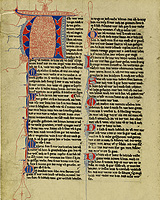Codex Manesse: Original manuscript from Middle Ages to be on exhibit
11 June 2010

To mark the 625th anniversary of Heidelberg University, one of the most significant manuscripts of the Middle Ages, the 14th century Codex Manesse, will be on view to the public for the first time in years. The University Library will feature the magnificent collection of songs and verses in Middle High German, which rarely leaves the air-conditioned environs of the library’s vault, in an exhibit entitled “The Codex Manesse and the Discovery of Love” beginning in October. The exhibit is an integral part of the major program of events the university is preparing for the public for the anniversary year from October 2010 to October 2011.
The core of the Codex Manesse was compiled around 1300 in Zurich – presumably at the behest of Rüdiger Manesse and his son Johann, who wanted a comprehensive collection of Middle High German poetry and song in their many genres and forms. Addenda were incorporated into the codex around 1340. The manuscript consists of 426 sheets of parchment, inscribed on both sides, with verse from 140 poets. The oldest texts stem from the mid 12th century; many of the verses can be found only in the codex, making the manuscript one of the most significant artefacts of literature and culture of the Staufer era.
Miniatures, 138 in all, introduce the text. These idealised depictions of the poets going about their activities at court are considered outstanding examples of Gothic illumination from the Upper Rhine region. The songs are arranged according to the rank of the author. As the most noble contributors, the Hohenstaufen dynasty rulers Emperor Henry VI and King Conradin are first, followed by princes, “gentlemen” and personages such as Walther von der Vogelweide and Wolfram von Eschenbach, who were poets by profession. The manuscript, also known as the “Große Heidelberger Liederhandschrift” is considered the definitive representative collection of medieval lay songs.
The codex is known to have been in the possession of the Heidelberg Prince-Electors since the early 17th century. Prior to the conquest of Heidelberg by Catholic league troupes in 1622, it is assumed to have accompanied the royal family into exile. In need of funds, the widow of Prince-Elector Frederick V probably sold the manuscript after his death in 1632. From 1657 onward the codex was held by the Royal Library in Paris, now the National Library of France. It was returned to Heidelberg in 1888 after elaborate negotiations between the French, English and Germans.
To celebrate the founding of Heidelberg University, the University Library will be exhibiting this most valuable treasure in the original. The exhibit will run in parallel with the larger “The Hohenstaufen Dynasty and Italy” exhibition at the Reiss-Engelhorn-Museen Mannheim from September of this year to February of 2011.
For details, see http://manesse2010.uni-hd.de
Note to editorial staff:
Digital pictures available from the Press Office.
Contact:
Dr. Sabine Häußermann
Heidelberg University Library
Phone +49 6221 542581
haeussermann@ub.uni-heidelberg.de
Communications and Marketing
Press Office, phone: +49 6221 542311
presse@rektorat.uni-heidelberg.de

